Abstract
Experiments were designed to test suture materials for their use in potentially infected abdominal wound closure. The nearest to the ideal, at present available, is a monofilament nonabsorbable suture, the one tested being monofilament nylon. The suture retained adequate strength in the infected and noninfected state over a 70-day period. This is particularly important as infection has been shown to result in low wound strength in the early phases of healing. The monofilamentous nature of this suture represented an advantage when sutures were examined electronmicroscopically. Infected, braided sutures viewed for the first time by electronmicroscopy were shown to contain bacteria and polymorphonuclear cells, even after 70 days implantation. The normal absorption and encapsulation of these sutures was delayed by the presence of infection. Polyglycolic acid had marked strength when new but rapidly weakened after implantation. This together with slowed absorption in the infected state is a disturbing feature in terms of wound failure and sinus formation respectively.
Full text
PDF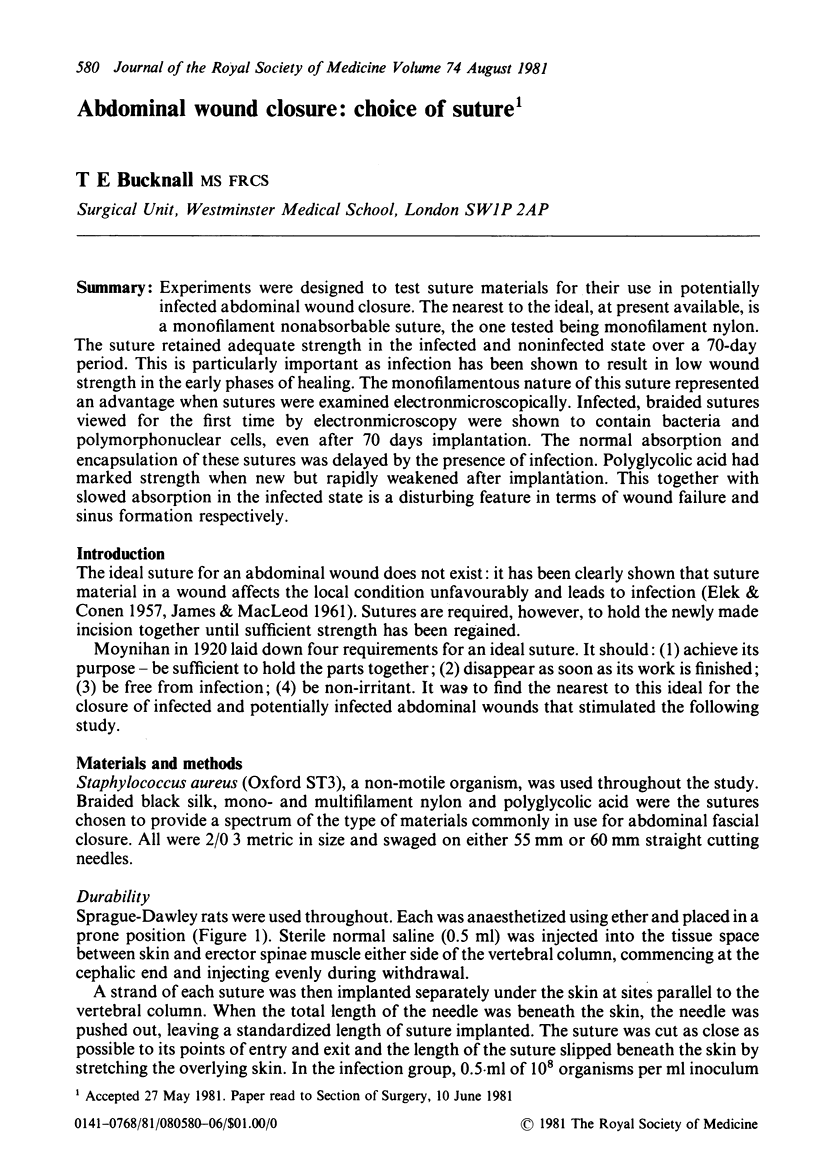
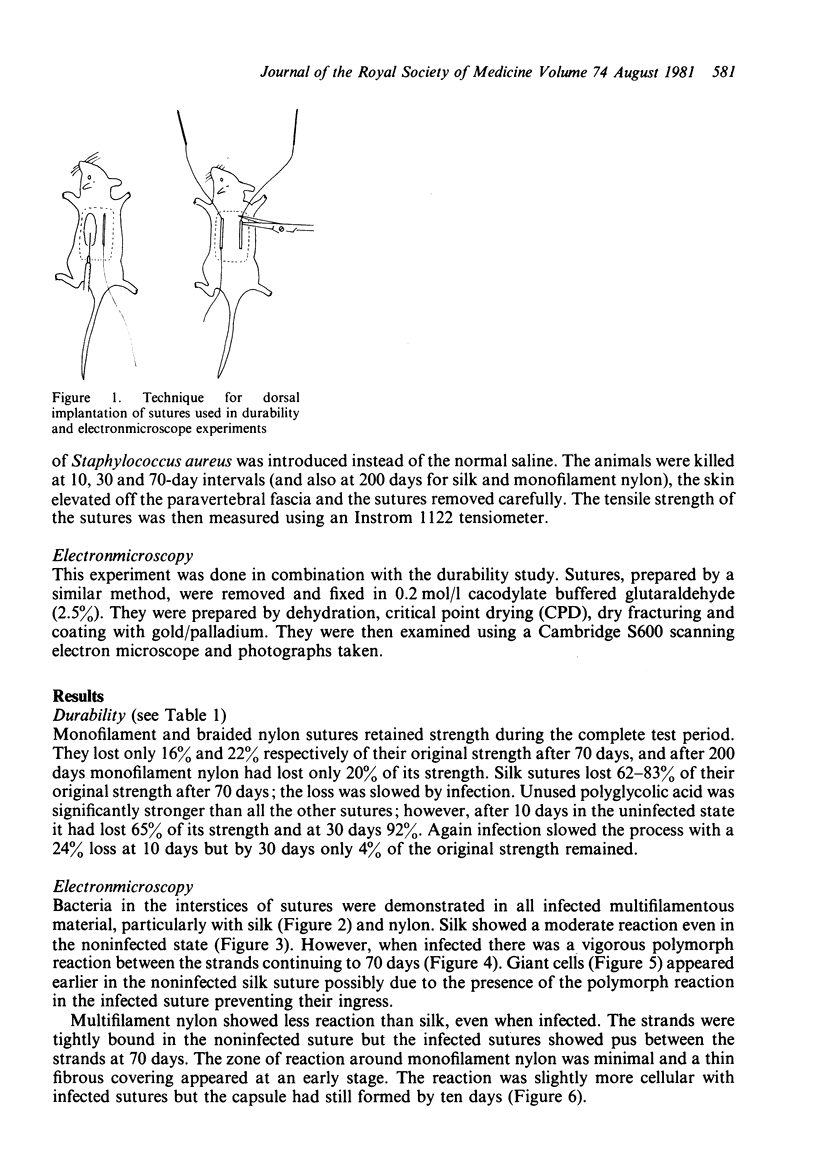
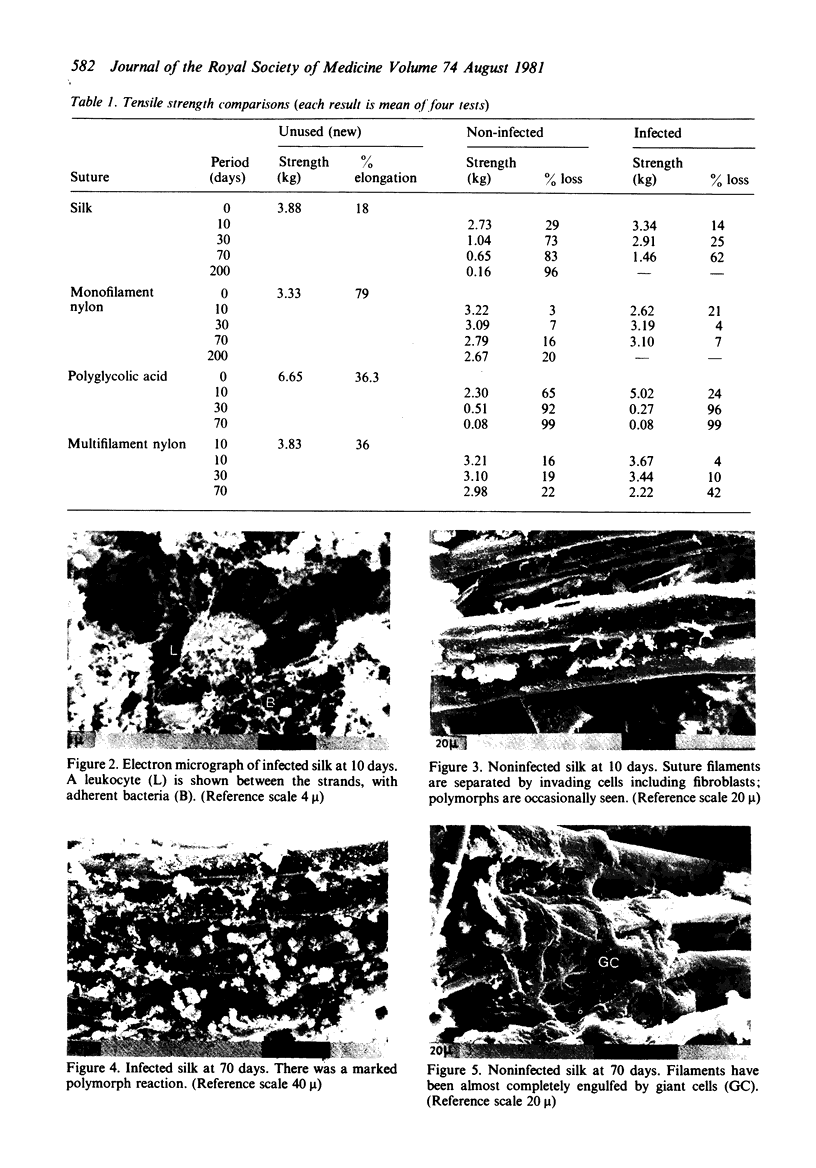
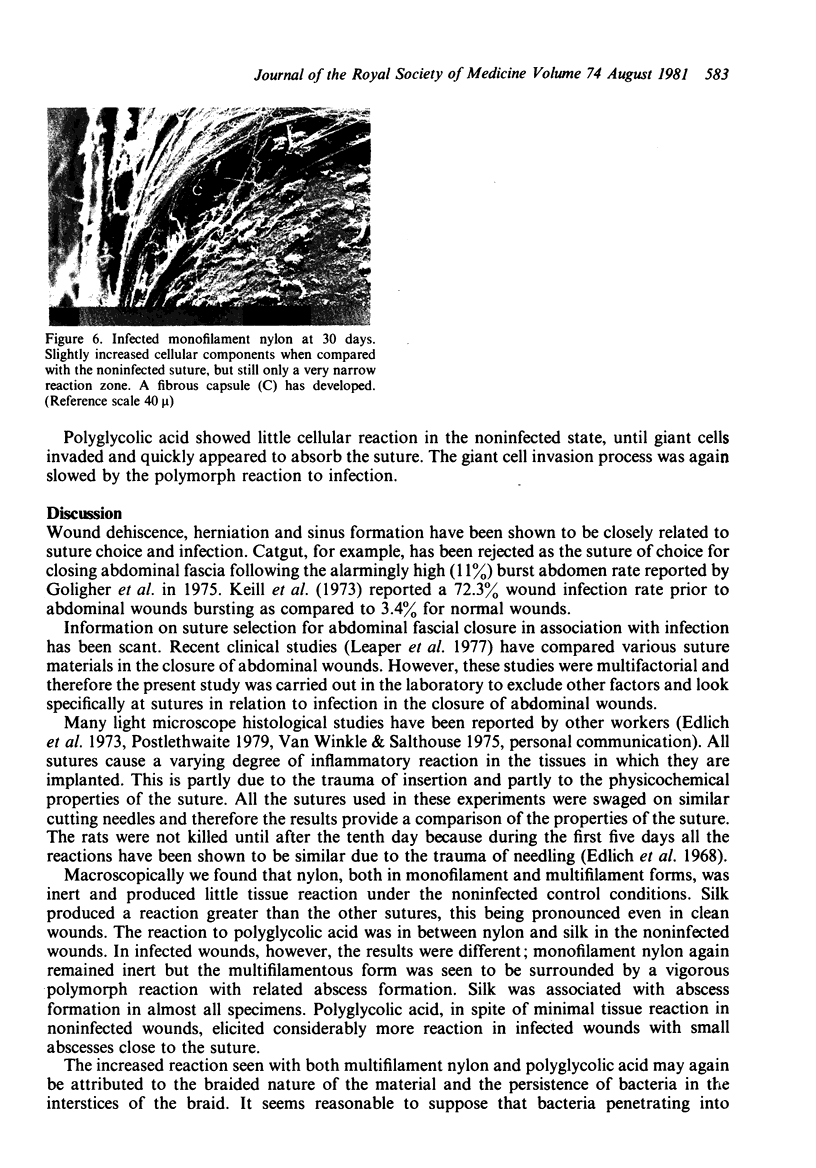
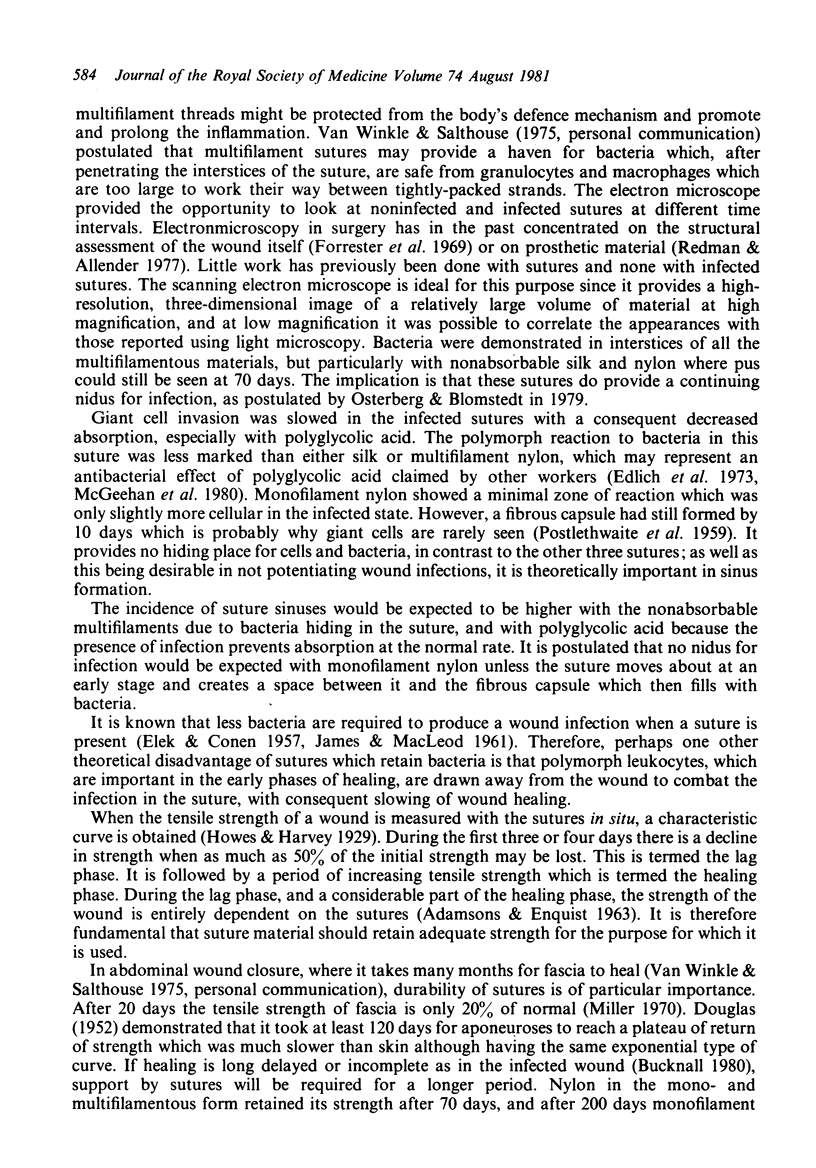
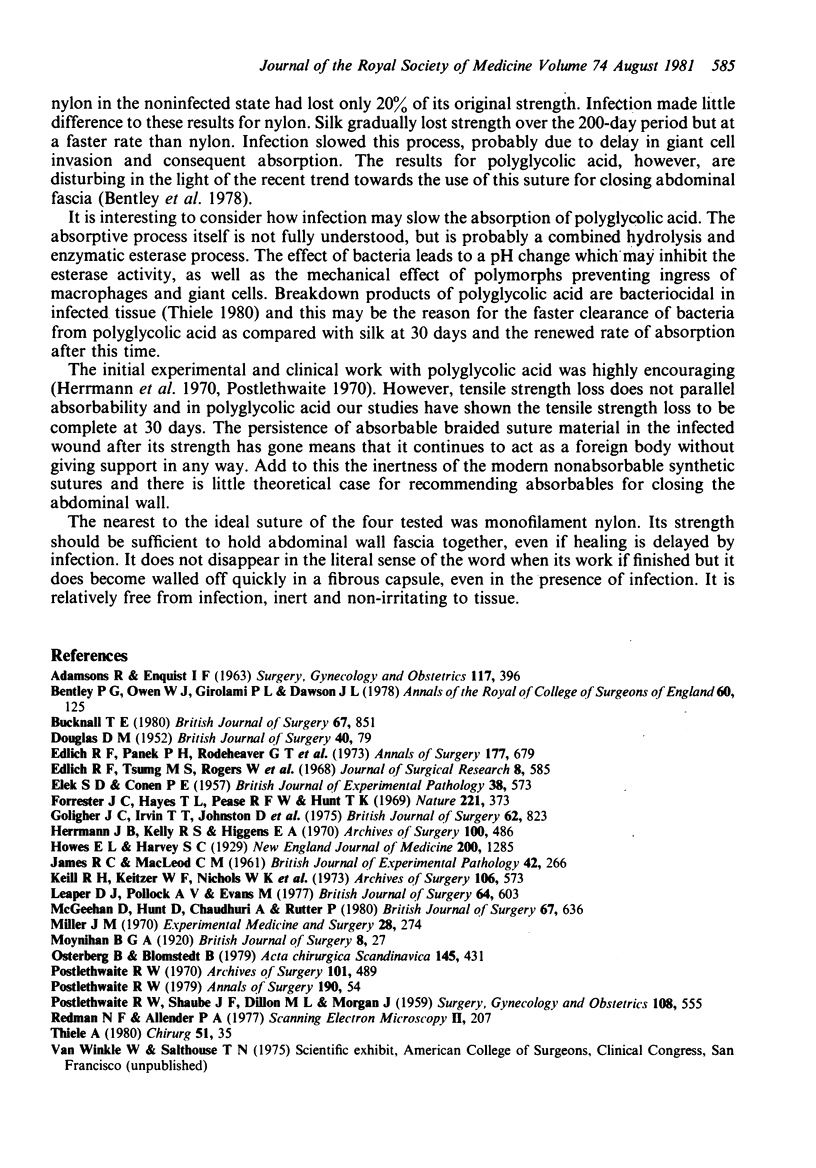
Images in this article
Selected References
These references are in PubMed. This may not be the complete list of references from this article.
- Bentley P. G., Owen W. J., Girolami P. L., Dawson J. L. Wound closure with Dexon (polyglycolic acid) mass suture. Ann R Coll Surg Engl. 1978 Mar;60(2):125–127. [PMC free article] [PubMed] [Google Scholar]
- Bucknall T. E. The effect of local infection upon wound healing: an experimental study. Br J Surg. 1980 Dec;67(12):851–855. doi: 10.1002/bjs.1800671205. [DOI] [PubMed] [Google Scholar]
- DOUGLAS D. M. The healing of aponeurotic incisions. Br J Surg. 1952 Jul;40(159):79–84. doi: 10.1002/bjs.18004015918. [DOI] [PubMed] [Google Scholar]
- ELEK S. D., CONEN P. E. The virulence of Staphylococcus pyogenes for man; a study of the problems of wound infection. Br J Exp Pathol. 1957 Dec;38(6):573–586. [PMC free article] [PubMed] [Google Scholar]
- Edlich R. F., Panek P. H., Rodeheaver G. T., Turnbull V. G., Kurtz L. D., Edgerton M. T. Physical and chemical configuration of sutures in the development of surgical infection. Ann Surg. 1973 Jun;177(6):679–688. doi: 10.1097/00000658-197306000-00006. [DOI] [PMC free article] [PubMed] [Google Scholar]
- Edlich R. F., Tsung M. S., Rogers W., Rogers P., Wangensteen O. H. Studies in management of the contaminated wound. I. Technique of closure of such wounds together with a note on a reproducible experimental model. J Surg Res. 1968 Dec;8(12):585–592. doi: 10.1016/0022-4804(68)90013-9. [DOI] [PubMed] [Google Scholar]
- Forrester J. C., Hunt T. K., Hayes T. L., Pease R. F. Scanning electron microscopy of healing wounds. Nature. 1969 Jan 25;221(5178):373–374. doi: 10.1038/221373a0. [DOI] [PubMed] [Google Scholar]
- Goligher J. C., Irvin T. T., Johnston D., De Dombal F. T., Hill G. L., Horrocks J. C. A controlled clinical trial of three methods of closure of laparotomy wounds. Br J Surg. 1975 Oct;62(10):823–829. doi: 10.1002/bjs.1800621019. [DOI] [PubMed] [Google Scholar]
- Herrmann J. B., Kelly R. J., Higgins G. A. Polyglycolic acid sutures. Laboratory and clinical evaluation of a new absorbable suture material. Arch Surg. 1970 Apr;100(4):486–490. doi: 10.1001/archsurg.1970.01340220162027. [DOI] [PubMed] [Google Scholar]
- JAMES R. C., MACLEOD C. J. Induction of staphylococcal infections in mice with small inocula introduced on sutures. Br J Exp Pathol. 1961 Jun;42:266–277. [PMC free article] [PubMed] [Google Scholar]
- Keill R. H., Keitzer W. F., Nichols W. K., Henzel J., DeWeese M. S. Abdominal wound dehiscence. Arch Surg. 1973 Apr;106(4):573–577. doi: 10.1001/archsurg.1973.01350160185032. [DOI] [PubMed] [Google Scholar]
- Leaper D. J., Pollock A. V., Evans M. Abdominal wound closure: a trial of nylon, polyglycolic acid and steel sutures. Br J Surg. 1977 Aug;64(8):603–606. doi: 10.1002/bjs.1800640822. [DOI] [PubMed] [Google Scholar]
- McGeehan D., Hunt D., Chaudhuri A., Rutter P. An experimental study of the relationship between synergistic wound sepsis and suture materials. Br J Surg. 1980 Sep;67(9):636–638. doi: 10.1002/bjs.1800670909. [DOI] [PubMed] [Google Scholar]
- Miller J. M. A new era of non-absorbable sutures. Exp Med Surg. 1970;28(3):274–280. [PubMed] [Google Scholar]
- Osterberg B., Blomstedt B. Effect of suture materials on bacterial survival in infected wounds. An experimental study. Acta Chir Scand. 1979;145(7):431–434. [PubMed] [Google Scholar]
- Postlethwait R. W. Five year study of tissue reaction to synthetic sutures. Ann Surg. 1979 Jul;190(1):54–57. doi: 10.1097/00000658-197907000-00012. [DOI] [PMC free article] [PubMed] [Google Scholar]
- Postlethwait R. W. Polyglycolic acid surgical suture. Arch Surg. 1970 Oct;101(4):489–494. doi: 10.1001/archsurg.1970.01340280041011. [DOI] [PubMed] [Google Scholar]
- Thiede A., Jostarndt L., Lünstedt B., Sonntag H. G. Kontrollierte experimentelle histologische und mikrobiologische Untersuchungen zur Hemmwirkung von Polyglycolsäurefäden bei Infektionen. Chirurg. 1980 Jan;51(1):35–38. [PubMed] [Google Scholar]







